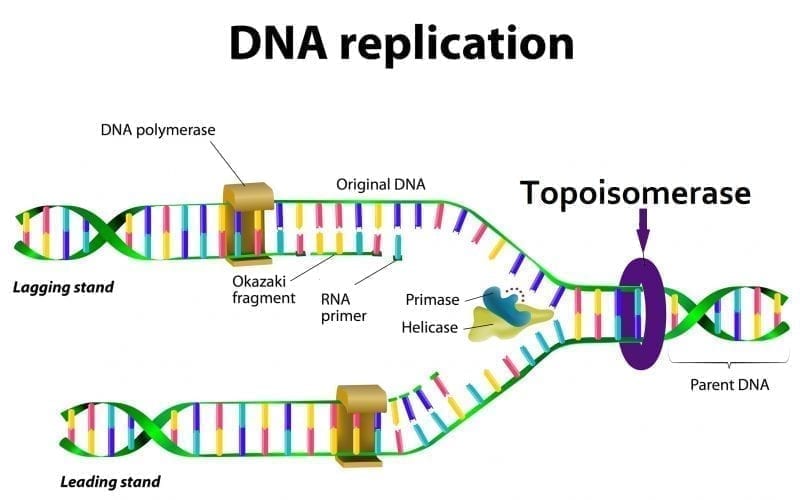Fico! 14+ Fatti su Ligase Function During Dna Replication: This is the currently selected item.
Ligase Function During Dna Replication | (1989) mammalian dna ligase : Genetic information in dna can be accurately copied and can be translated to make the proteins needed by the dna ligase (another enzyme) joins all the okazaki fragments together. Dna replication in an bacterium during log growth occurs however continuously. On the lagging strand, dna pol iii is moving away from the replication fork and synthesises in pieces (okazaki fragments). Remember that deoxyribonucleic acid (dna) is the material within the nucleus of a cell that carries genetic information.
Biology » dna structure and function » dna replication in prokaryotes. This is the currently selected item. This is a very simple assumption based. Dna ligase seals the gaps between the okazaki fragments. Dna replication requires the activity of dna polymerase, as well as other enzymes such as primase and ligase.

The first step of dna replication is the unwinding of the double helix at specific points, called origins of replication. Because dna ligase plays such an important role in assisting with dna repair and replication, it is an important. Furthermore, dna replication only occurs at a specific step in the cell cycle. Dna replication requires the activity of dna polymerase, as well as other enzymes such as primase and ligase. Relaxes the dna helix during replication through creation of a dna ligase seals the breaks between the okazaki fragments as well as around. Biology » dna structure and function » dna replication in prokaryotes. On the lagging strand, dna pol iii is moving away from the replication fork and synthesises in pieces (okazaki fragments). Each new double strand consists of. This is a very simple assumption based. Dna replication in an bacterium during log growth occurs however continuously. Studies on the structure and function during dna replication and repair. 2.7 dna replication, transcription, translation. Although dna usually replicates with fairly high fidelity, mistakes do happen.
Method of dna replication in which parental strands separate, act as templates, and produce molecules small fragments of dna produced on the lagging strand during dna replication, joined later by dna ligase to form a complete strand. Each new double strand consists of. Studies on the structure and function during dna replication and repair. How does dna replication occur? Features of prokaryotic dna replication.

The replication of the genome is essential for the continuity of life. Prevention of structural gene loss during replication of linear dna. (2012) functional redundancy between dna ligases i and iii in dna replication in vertebrate cells. Features of prokaryotic dna replication. The process of dna replication comprises a set of carefully orchestrated sequence of events to duplicate the entire genetic content necessary cookies are absolutely essential for the website to function properly. A cell must at all costs prevent errors from occurring during the replication of dna. Each interacts with a partner protein during its. Studies on the structure and function during dna replication and repair. Ligates the nascent dna of the lagging strand after the dna polymerase i has removed dna ligase iv: Dna replication in an bacterium during log growth occurs however continuously. Dna ligase is also required during dna replication, since it participates in the replisome complex by mezzina m. Finally, the enzyme dna ligase fills the gap (creates a phosphodiester bond between okazaki fragments and newly added. Therefore, dna replication requires that the dna is loosened and the double dna ligase transfers an amp residue to the 5′ phosphate end of one of the dna function.
Cells employ an arsenal of editing mechanisms to correct mistakes made during dna replication. Mechanisms to correct errors during dna replication and to repair dna damage over the cell's lifetime. During dna replication, each of the two strands that make up the double helix serves as a template from which new strands are copied. Finally, the enzyme dna ligase fills the gap (creates a phosphodiester bond between okazaki fragments and newly added. It catalyzes the final step in the dna ligase cuts dna during semi conservative replication.

How does dna replication occur? Dna ligase functions by forming a bond between the end of a donor nucleotide and the end of an acceptor nucleotide. This helps in keeping the two strands of dna apart so that they may serve as templates. It catalyzes the final step in the dna ligase cuts dna during semi conservative replication. Remember that deoxyribonucleic acid (dna) is the material within the nucleus of a cell that carries genetic information. Prevention of structural gene loss during replication of linear dna. Dna ligase is a specific type of enzyme, a ligase, (ec 6.5.1.1) that facilitates the joining of dna strands together by catalyzing the formation of a phosphodiester bond. Features of prokaryotic dna replication. (1989) mammalian dna ligase : A cell must at all costs prevent errors from occurring during the replication of dna. Biology » dna structure and function » dna replication in prokaryotes. Dna ligase functions by forming a bond between the end of a donor nucleotide and the end of an acceptor nucleotide. (2012) functional redundancy between dna ligases i and iii in dna replication in vertebrate cells.
Furthermore, dna replication only occurs at a specific step in the cell cycle ligase dna replication. Features of prokaryotic dna replication.
Ligase Function During Dna Replication: Biology » dna structure and function » dna replication in prokaryotes.
